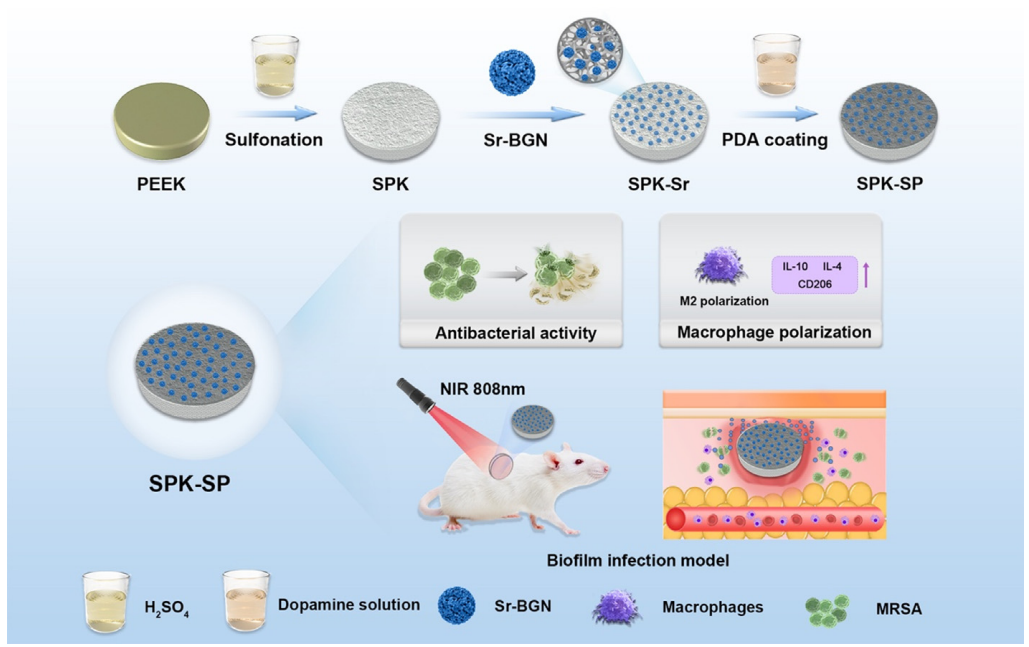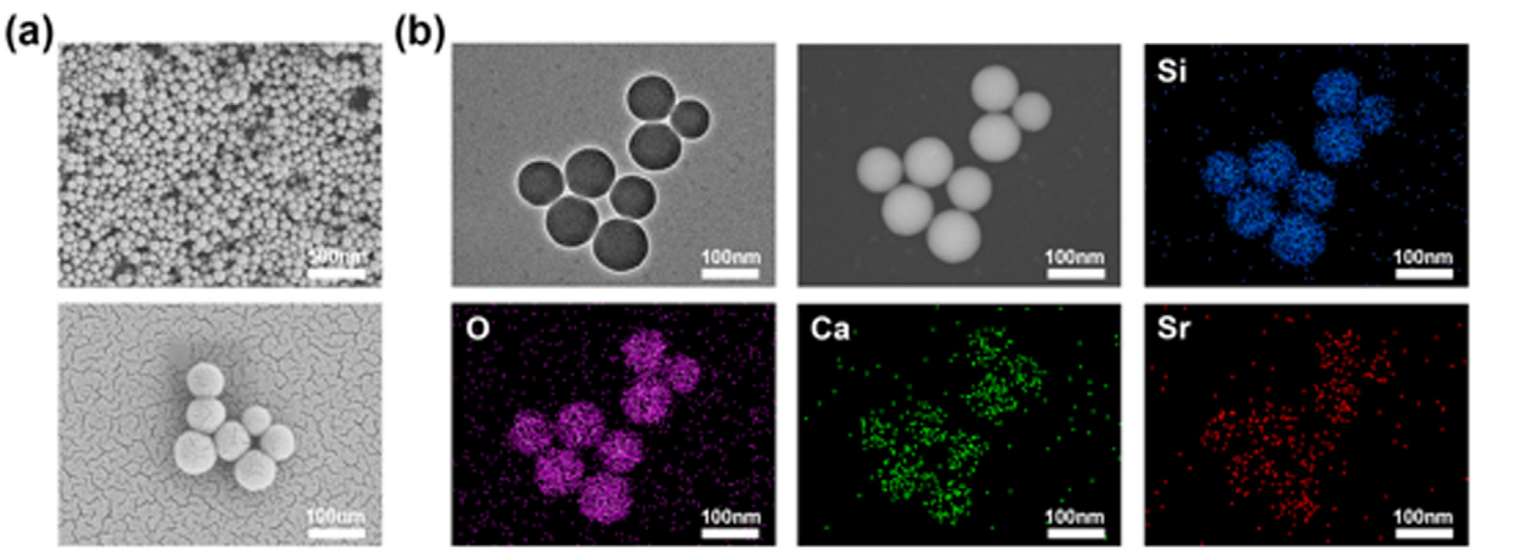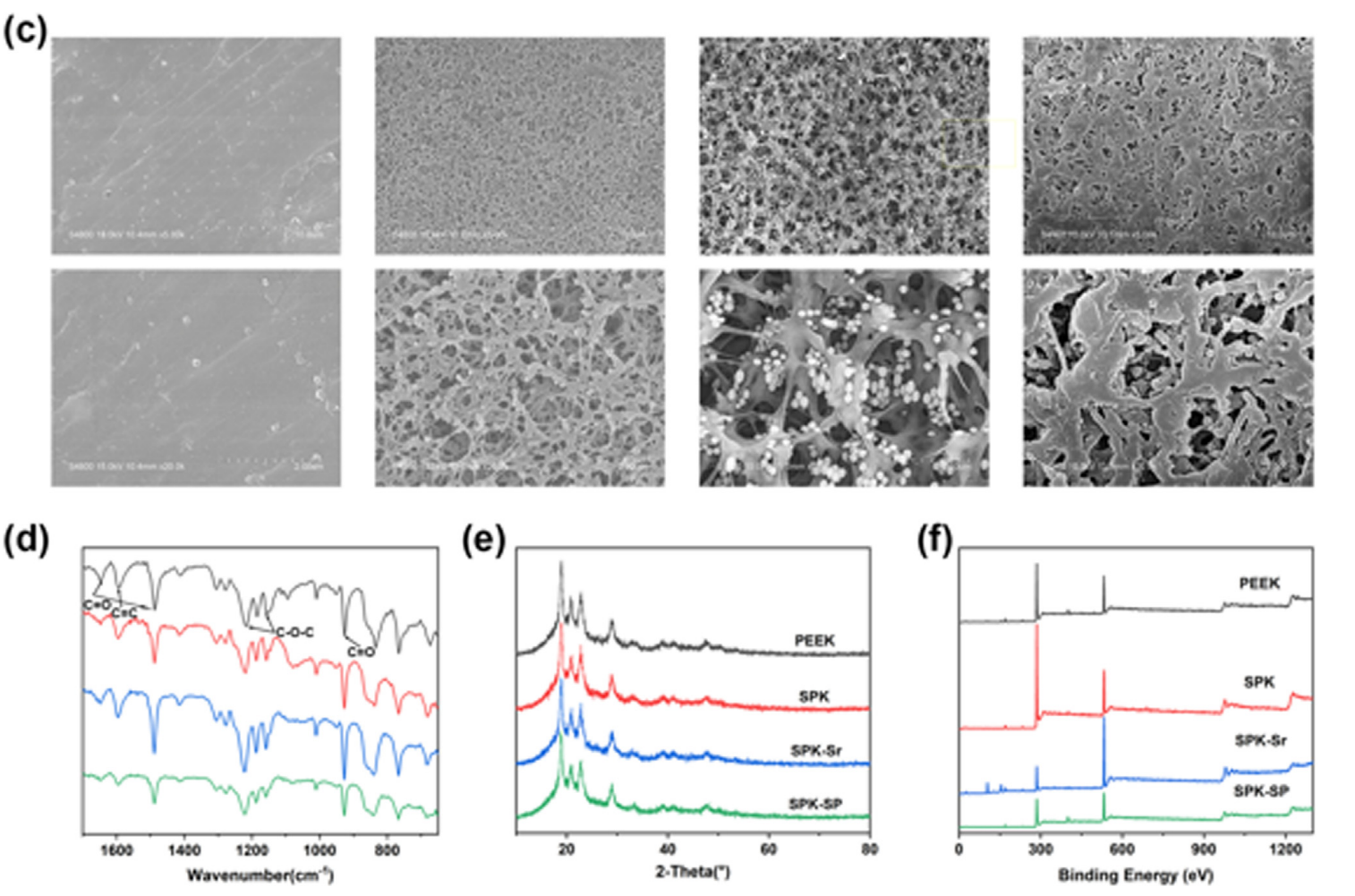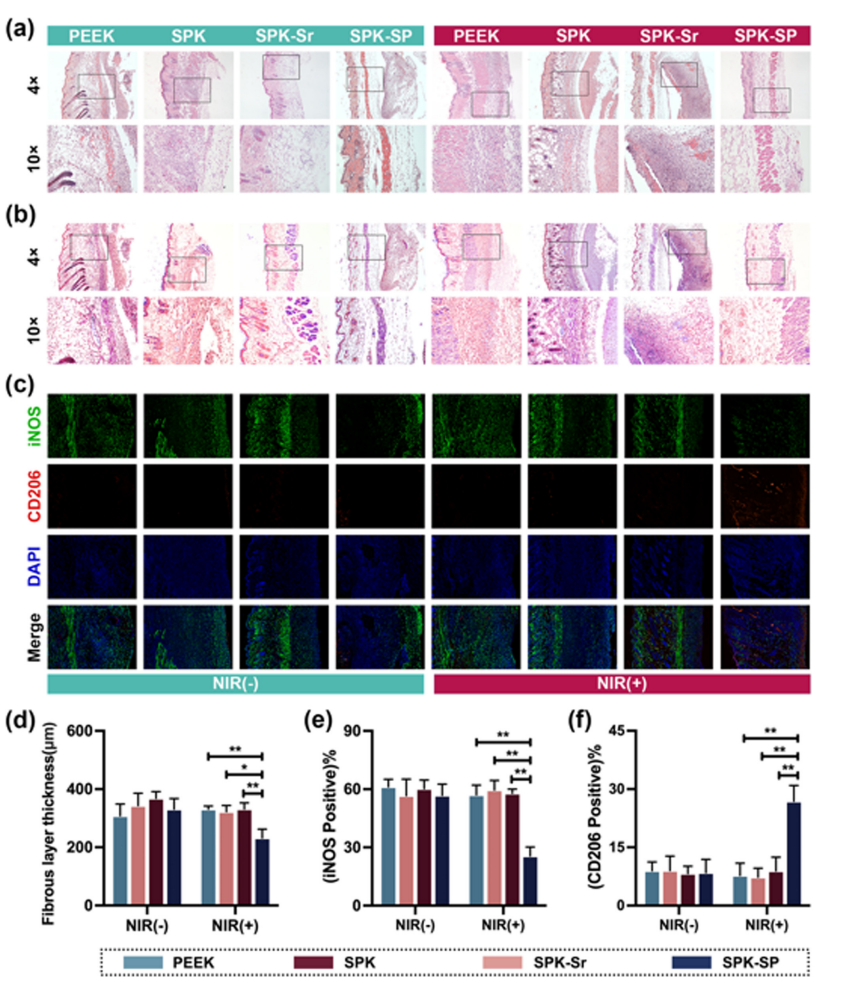Editor: Nina
Scientists develop a strontium-doped bioactive glass and polydopamine functionalized polyetheretherketone implant system to enhance antibacterial efficacy and promote tissue repair against methicillin-resistant Staphylococcus aureus infections through photothermal therapy and immunomodulation.
Key Preview
Research Question
The study addresses the critical issue of postoperative infections associated with orthopedic implants, particularly those caused by biofilm-forming bacteria like methicillin-resistant Staphylococcus aureus (MRSA). The research aims to investigate how a novel strontium-doped bioactive glass (Sr-BGNs) coating combined with polydopamine (PDA) can enhance the antibacterial properties of polyetheretherketone (PEEK) implants and improve tissue repair.
Research Design and Strategy
The researchers designed a multifunctional orthopedic implant by incorporating Sr-BGNs into PDA-coated PEEK substrates. This innovative approach combines photothermal therapy and immunomodulatory properties to tackle biofilm infections effectively. The study employs both in vitro and in vivo experiments to evaluate the efficacy of the engineered implants against MRSA biofilms.
Method
The study involved the synthesis of Sr-BGNs, modification of PEEK with a sulfonation process to create a porous structure, and subsequent coating with PDA. The antibacterial activity was evaluated using bacterial viability assays, biofilm inhibition tests, and assessments of macrophage polarization and tissue compatibility.
Key Results
The results demonstrated that the Sr-BGNs/PDA-coated implants exhibited a remarkable 95% antibacterial efficiency against MRSA when exposed to near-infrared (NIR) irradiation. The implants not only efficiently disrupted biofilms but also promoted an anti-inflammatory response, favoring macrophage polarization towards the M2 phenotype, which is beneficial for tissue repair.
Significance of the Research
This research presents a promising advancement in the field of orthopedic implants by addressing the significant challenge of implant-related infections. The synergistic effects of photothermal therapy and immunomodulation could lead to improved clinical outcomes for patients, reducing the incidence of postoperative infections and enhancing the healing process.
Introduction
Orthopedic implant-related infections, particularly those caused by biofilm-forming bacteria such as methicillin-resistant Staphylococcus aureus (MRSA), pose a significant challenge in clinical settings. These infections can lead to severe complications, including prolonged hospitalization, increased healthcare costs, and in some cases, necessitate the removal of the implant itself. The presence of biofilms on implants creates a protective environment for bacteria, allowing them to evade both the host immune response and the effects of antibiotic therapies. As a result, the management of these infections has become increasingly complex and critical in ensuring successful surgical outcomes.
Traditionally, the treatment of implant-related infections involves the systemic delivery of antibiotics, often administered intravenously or orally. This approach aims to reduce bacterial load and eliminate pathogens from the bloodstream. However, the efficacy of this strategy is limited by several factors, including the inability of antibiotics to penetrate biofilms effectively and the emergence of antibiotic-resistant strains of bacteria. Additionally, systemic administration can lead to suboptimal drug concentrations at the site of infection, resulting in treatment failures and recurrent infections.
The challenges inherent in current antibiotic delivery strategies culminate in significant clinical consequences, including prolonged infections, increased rates of implant failure, and the need for additional surgeries. Moreover, the growing prevalence of antibiotic resistance complicates treatment options, highlighting the urgent need for innovative approaches to prevent and manage infections associated with orthopedic implants.
In response to these challenges, the present study introduces a novel drug delivery strategy that employs a multifunctional coating of strontium-doped bioactive glass nanoparticles (Sr-BGNs) combined with polydopamine (PDA) on polyetheretherketone (PEEK) implants. This innovative approach not only enhances the antibacterial properties of the implants through photothermal therapy but also promotes an immunomodulatory response that favors tissue repair. By leveraging the unique properties of Sr-BGNs and PDA, this strategy aims to improve the efficacy of local drug delivery, combat biofilm formation, and ultimately enhance patient outcomes following orthopedic surgeries. The integration of these advanced materials represents a promising advancement in the field of biomedical implants, particularly in the context of addressing the critical issue of implant-related infections.
Research Team and Aim
The research team for this study was led by Dr. Xinjin Su, along with co-researchers Zhuocheng Lyu and Yuezhou Wu, all affiliated with Renji Hospital, School of Medicine, Shanghai Jiao Tong University. This research was conducted between November and December 2022, culminating in the publication of their findings in the paper titled “Strontium-doped bioactive glass/PDA functionalized polyetheretherketone with immunomodulatory property for enhancing photothermal clearance of Staphylococcus aureus” in the journal Materials & Design.
The aim of this research, as articulated by Dr. Xinjin Su, was to fabricate a multifunctional orthopedic implant that enhances antibacterial efficacy through a unique coating strategy. The study sought to reduce postoperative infection rates and improve recovery outcomes in orthopedic surgeries by leveraging the synergistic effects of strontium-doped bioactive glass nanoparticles and polydopamine on PEEK implants.
Experimental Process

Figure 1. Schematic representation of the fabrication process used to prepare the SPK-SP
Primary Technique: Multifunctional Coating Fabrication and Evaluation
The primary technique used in this study involves the fabrication of a multifunctional strontium-doped bioactive glass nanoparticles (Sr-BGNs) coating combined with polydopamine (PDA) on polyetheretherketone (PEEK) implants. This innovative method aims to enhance the antibacterial properties and immunomodulatory effects of the implants, specifically targeting methicillin-resistant Staphylococcus aureus (MRSA) biofilm infections.
Experiment 1: Synthesis of Sr-BGNs
Key Steps:
- Preparation: Sr-BGNs were synthesized using a sol-gel method. The precursor solutions containing SiO2, CaO, and SrO were mixed in appropriate molar ratios.
- Gelation: The solution was stirred and allowed to gel at room temperature before being dried to form a glass.
- Heat Treatment: The precursor glass was then heat-treated at 600°C for 2 hours, followed by grinding to obtain fine nanoparticles.
Data Collection and Analysis:
- The morphology and size of Sr-BGNs were analyzed using scanning electron microscopy (SEM) and transmission electron microscopy (TEM).

Figure 2. (a) SEM images of Sr-BGNs. (b) TEM images of Sr-BGNs.
Result:
- The synthesized Sr-BGNs exhibited a spherical morphology with an average particle size of approximately 100 nm, confirmed by SEM and TEM imaging.
Novel Aspect:
- The synthesis of Sr-BGNs using a sol-gel method allows for controlled doping of strontium, which enhances bioactivity compared to traditional bioactive glasses that do not incorporate Sr.
Experiment 2: Modification of PEEK Surface
Key Steps:
- Surface Preparation: PEEK samples were ultrasonically cleaned and then subjected to a sulfonation process in sulfuric acid to create a porous structure.
- Coating Application: The sulfonated PEEK (SPK) was immersed in a solution containing Sr-BGNs (0.5 mg/mL) for 20 seconds and subsequently hydrothermally treated at 120°C for 24 hours.
- Polydopamine Coating: The SPK-Sr samples were then placed in a dopamine solution (1 mg/mL, pH 8.5) and stirred overnight to form the Sr-BGNs/PDA composite coating.
Data Collection and Analysis:
- The successful modification of the PEEK surface was characterized by SEM and Fourier-transform infrared spectroscopy (FTIR) to confirm the presence and distribution of Sr-BGNs and PDA.

Figure 3. c) Surface SEM images of various samples. (d) FTIR spectra.
Result:
- The surface of the PEEK implants displayed a well-defined porous structure with Sr-BGNs uniformly distributed, verified by SEM imaging.
Novel Aspect:
- This approach combines bioactive glass nanoparticles with PDA, which is not commonly found in existing implant coatings, thereby introducing a unique immunomodulatory and photothermal effect.
Experiment 3: Antibacterial Activity Evaluation
Key Steps:
- Bacterial Culture: MRSA (ATCC 43300) was cultured in tryptic soy broth until reaching exponential growth.
- Co-culture with Implants: Bacterial suspension (1 × 10^6 CFU/mL) was co-cultured with various PEEK samples, including control, SPK, SPK-Sr, and SPK-SP, either with or without near-infrared (NIR) laser irradiation (1.5 W/cm²) for 10 minutes.
- Viability Assessment: After 24 hours, bacterial viability was evaluated using the microbial viability kit and spread plate method to determine colony-forming units (CFUs).
Data Collection and Analysis:
- Data were analyzed using the antibacterial efficiency formula: ( \text{Antibacterial efficiency} (%) = \frac{(Nc – NH)}{Nc} \times 100 ), where Nc is the CFUs of control, and NH is the CFUs of the treated samples.
Result:
- SPK-SP with NIR showed a remarkable 95% antibacterial efficiency against MRSA, while the other groups exhibited significantly lower bactericidal effects.
Novel Aspect:
- The incorporation of PDA allows the SPK-SP implants to effectively utilize photothermal therapy, enhancing antibacterial action compared to traditional coatings lacking this feature.
Experiment 4: In Vivo Anti-Biofilm Evaluation
Key Steps:
- Animal Model Preparation: Female BALB/c mice were implanted subcutaneously with various PEEK samples (PEEK, SPK, SPK-Sr, SPK-SP) after anesthesia and surgical preparation.
- NIR Treatment: The implanted sites were irradiated with NIR laser (1.5 W/cm²) for 10 minutes daily for one week.
- Sample Collection: At the end of the experiment, the implants and surrounding tissues were collected, and bacterial burden was assessed using the spread plate method.
Data Collection and Analysis:
- Quantitative analysis of CFUs was performed on the harvested samples, and histological evaluation was conducted using hematoxylin and eosin (H&E) staining.

Figure 4. Histological evaluation of infected soft tissues.
Result:
- The SPK-SP + NIR group demonstrated a significant reduction in bacterial burden and a milder inflammatory response in the surrounding tissues compared to other groups.
Novel Aspect:
- This experiment highlights the dual functionality of the Sr-BGNs/PDA coating in providing antibacterial activity and promoting tissue repair, showcasing a significant advancement over traditional antibacterial coatings that only target bacterial pathogens.
Conclusion
The successful development of the strontium-doped bioactive glass nanoparticles (Sr-BGNs) combined with polydopamine (PDA) functionalized polyetheretherketone (PEEK) implant system represents a significant advancement in the fight against orthopedic implant-related infections. This innovative drug delivery system has been achieved through a robust methodology that incorporates the unique properties of Sr-BGNs to enhance bioactivity and the photothermal capabilities of PDA, which together facilitate effective antibacterial action against methicillin-resistant Staphylococcus aureus (MRSA) biofilms.
The highlights of the study underscore the multifaceted benefits of this novel approach: the engineered implants exhibited a remarkable 95% antibacterial efficiency against MRSA when exposed to near-infrared (NIR) irradiation, effectively disrupted biofilms, and promoted an anti-inflammatory response that favors macrophage polarization towards the M2 phenotype, thereby enhancing tissue repair. These findings suggest that the Sr-BGNs/PDA functionalized implants not only mitigate the risk of postoperative infections but also contribute to improved clinical outcomes by accelerating the healing process and reducing the need for additional surgical interventions.
Overall, this research paves the way for further exploration and application of multifunctional coatings in orthopedic implants, addressing the pressing challenges of antibiotic resistance and biofilm-related infections in the clinical setting.
Reference
Su, Xinjin, Zhuocheng Lyu, Yuezhou Wu, Yue-Huan Gu, Shicheng Huo, and Chun Zhou. “Strontium-doped bioactive glass/PDA functionalized polyetheretherketone with immunomodulatory property for enhancing photothermal clearance of Staphylococcus aureus.” Materials & Design, vol. 225, 2023, article 111552. doi:10.1016/j.matdes.2022.111552
